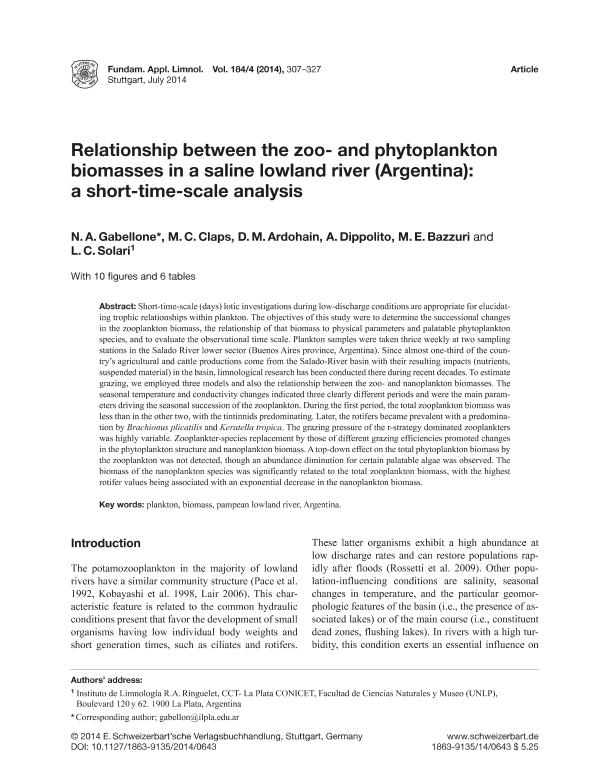Artículo
Relationship between the zoo- and phytoplankton biomasses in a saline lowland river (Argentina): a short-time-scale analysis
Gabellone, Nestor Adrian ; Claps, Maria Cristina
; Claps, Maria Cristina ; Ardohain, Diego Martin
; Ardohain, Diego Martin ; Dippolito, A.; Bazzuri, Maria Elisa
; Dippolito, A.; Bazzuri, Maria Elisa ; Solari, Lía Cristina
; Solari, Lía Cristina
 ; Claps, Maria Cristina
; Claps, Maria Cristina ; Ardohain, Diego Martin
; Ardohain, Diego Martin ; Dippolito, A.; Bazzuri, Maria Elisa
; Dippolito, A.; Bazzuri, Maria Elisa ; Solari, Lía Cristina
; Solari, Lía Cristina
Fecha de publicación:
07/2014
Editorial:
E Schweizerbartsche Verlags
Revista:
Fundamental And Applied Limnology
ISSN:
1863-9135
Idioma:
Inglés
Tipo de recurso:
Artículo publicado
Clasificación temática:
Resumen
Short-time-scale limnological investigations during low-discharge conditions are appropriate for elucidating trophic relationships within the plankton. The grazing pressure of the zooplankters, dominated by r-strategists, was highly variable; and zooplankter-species replacement by those of different grazing efficiencies promoted changes in the phytoplankton structure and nanoplankton biomass. Plankton samples were taken thrice weekly at two sampling stations in the Salado River lower sector (Buenos Aires province, Argentina). Since almost one-third of the country´s agricultural and cattle productions come from the Salado-River basin, limnological research has been conducted there during recent decades. The objectives of this study were to determine the succesional changes in the zooplankton biomass and the relationship of that biomass to physical parameters and palatable phytoplankton species and to evaluate the observational time scale. To estimate grazing we employed three models and also the relationship between the zoo- and nanoplankton biomasses. The seasonal temperature and conductivity changes indicated three clearly different periods and were the main parameters driving the seasonal succession of the zooplankton. During the first period, the total zooplankton biomass was less than in the other two, with the tintinnids predominating. Later, the rotifers became prevalent, with a predomination by Brachionus plicatilis and Keratella tropica. A top-down effect on the total phytoplankton biomass by the zooplankton was not detected, though a diminution in the values for certain palatable algae was observed. The biomass of the nanoplankton species was significantly related to the total zooplankton biomass, with the highest rotifer values being associated with an exponential decrease in the nanoplankton biomass.
Palabras clave:
Plankton
,
Biomass
,
Pampean Lowland River
,
Argentina
Archivos asociados
Licencia
Identificadores
Colecciones
Articulos(ILPLA)
Articulos de INST.DE LIMNOLOGIA "DR. RAUL A. RINGUELET"
Articulos de INST.DE LIMNOLOGIA "DR. RAUL A. RINGUELET"
Citación
Gabellone, Nestor Adrian; Claps, Maria Cristina; Ardohain, Diego Martin; Dippolito, A.; Bazzuri, Maria Elisa; et al.; Relationship between the zoo- and phytoplankton biomasses in a saline lowland river (Argentina): a short-time-scale analysis; E Schweizerbartsche Verlags; Fundamental And Applied Limnology; 184; 4; 7-2014; 307-327
Compartir
Altmétricas



